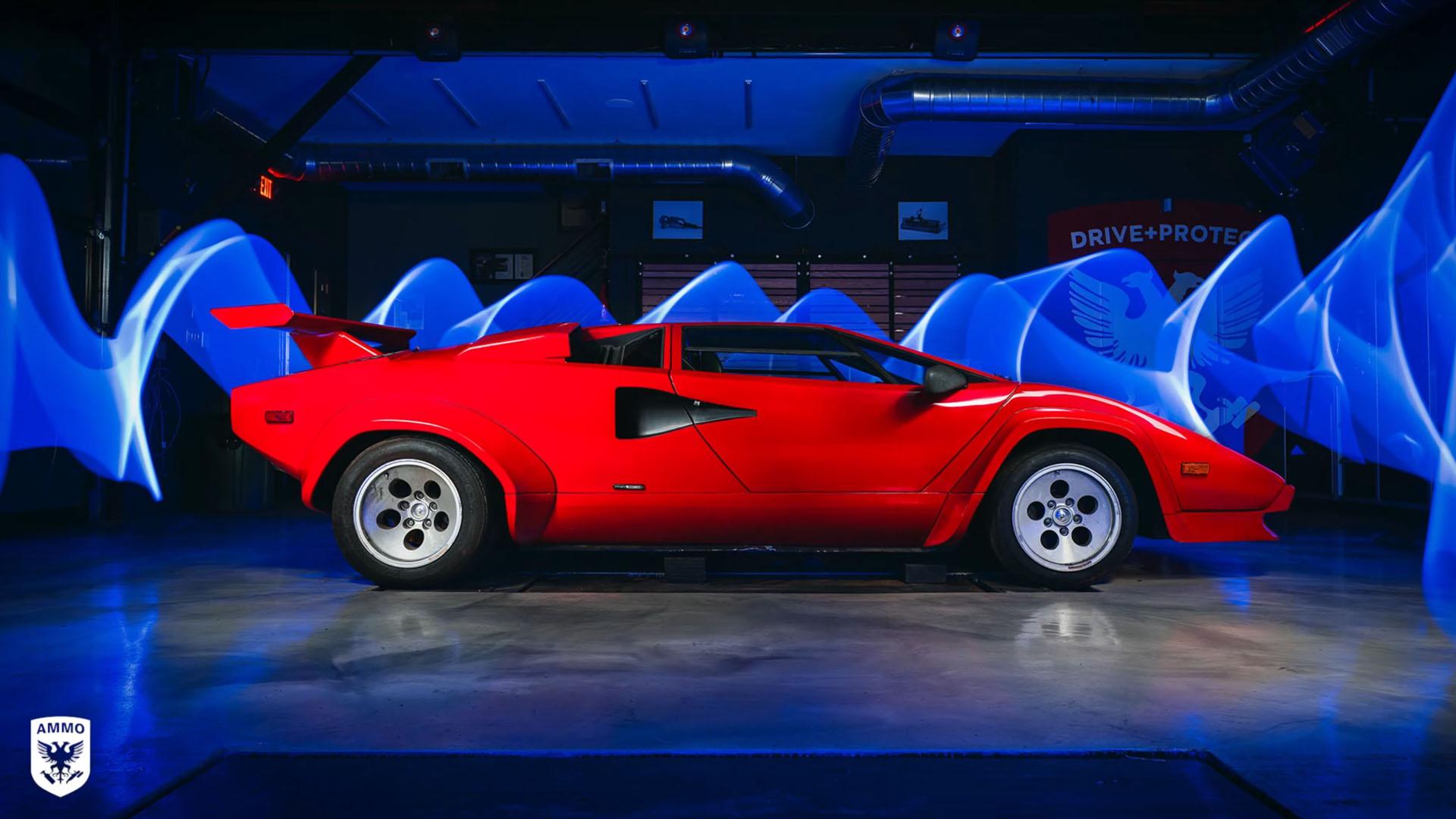A new breed of supercars is emerging, and these aren’t the typical low-slung, track-focused monsters we’ve come to adore; instead, they tread a path less traveled – quite literally. The 2023 Lamborghini Huracán Sterrato and the Porsche 911 Dakar represent this avant-garde movement, juxtaposing racetrack prowess with rugged off-road readiness. Both these supercars beckon a question that challenges the ethos of traditional supercar design, “Why confine adrenaline to the asphalt?”
Lamborghini and Porsche have been titans of performance for decades, with each iteration of their iconic models pushing boundaries and redefining the perception of speed. But now, with the Huracán Sterrato and 911 Dakar, they invite us into uncharted territory. Not merely content with ruling the racetrack, these vehicles venture into the dust-filled rally tracks, muddy trails, and the rocky challenges of the great outdoors.
This article delves deep into the ethos, engineering, and excitement offered by the Lamborghini Huracan Sterrato and the Porsche 911 Dakar, analyzing their capability both on and off the tarmac.
Lamborghini Huracán Sterrato vs Porsche 911 Dakar: DESIGN PHILOSOPHY
Quick Summary: the Lamborghini Huracán Sterrato emphasizes flamboyance with its expansive arch flares, a standout roof snorkel, pronounced front driving lights, practical roof rails, and a distinct blackout engine cover. Its design screams for attention, making it a clear winner in the head-turning contest.
The Porsche 911 Dakar leans more towards subtlety and heritage. Its increased ride height, black bumper inserts, fixed spoiler, and discreet arch extensions provide a distinct identity without overstepping into the realm of ostentation. It embodies a refined transformation, maintaining Porsche’s classic allure while signaling its off-road capabilities.
Lamborghini Huracán Sterrato
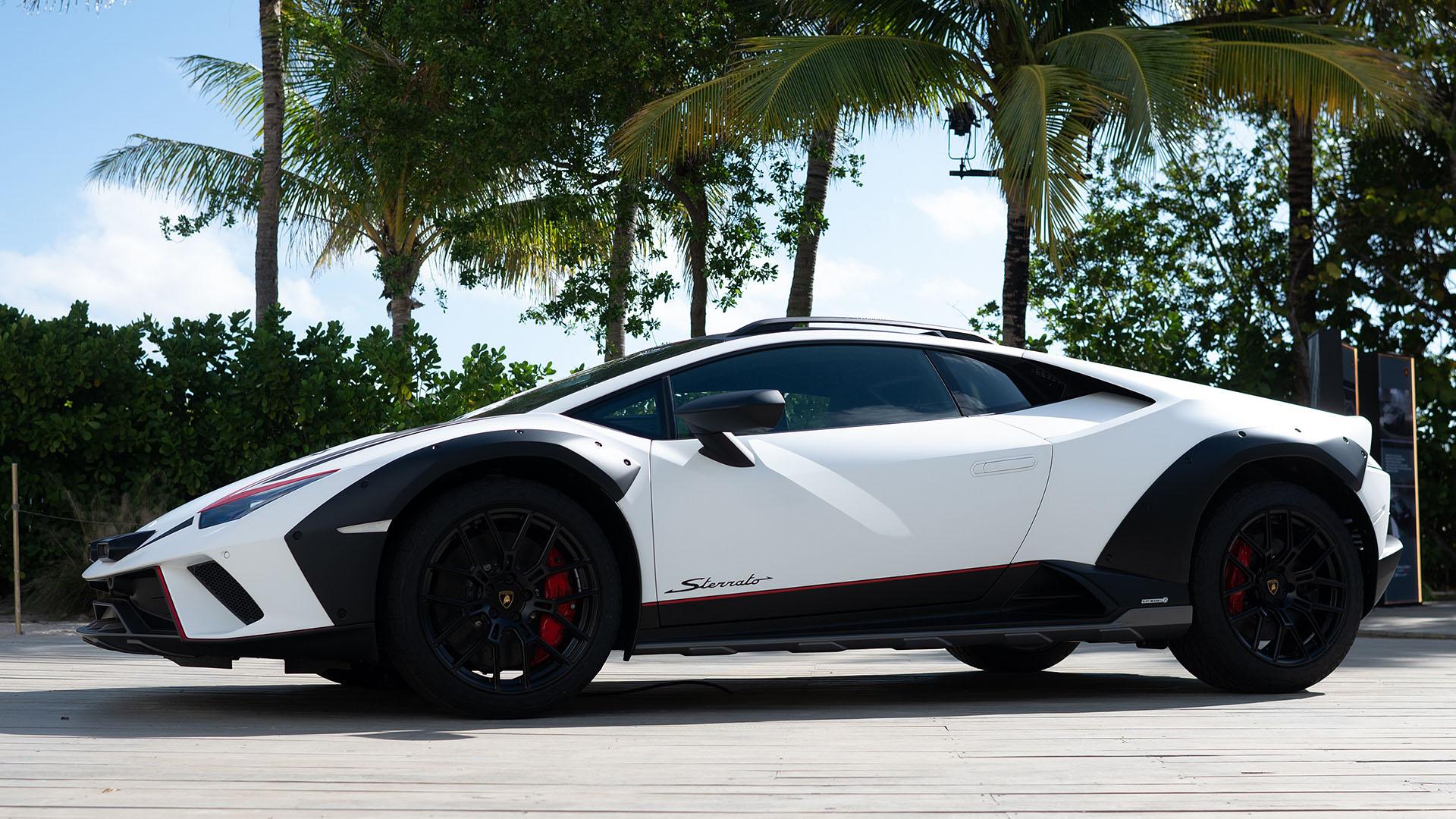
The Lamborghini Huracán, in its traditional form, is the embodiment of the classic supercar design, ensuring it’s always a magnet for attention. But with the introduction of the Sterrato, the stakes have been raised even further. Inspired by the classic Huracán, the Sterrato’s design is amplified with aggressive elements like its expansive arch flares, prominent roof snorkel, striking front driving lights, functional roof rails, and a distinct blackout engine cover. These features and the brand’s inherent Italian elegance ensure that the Sterrato remains unmatched in the “look-at-me” contest.
The heightened ride and bold aesthetic choices reveal the car’s dual personality: a luxury supercar with the heart of an off-roader. The design evolution speaks of Lamborghini’s prowess in seamlessly melding elegance with rugged functionality.
Porsche 911 Dakar
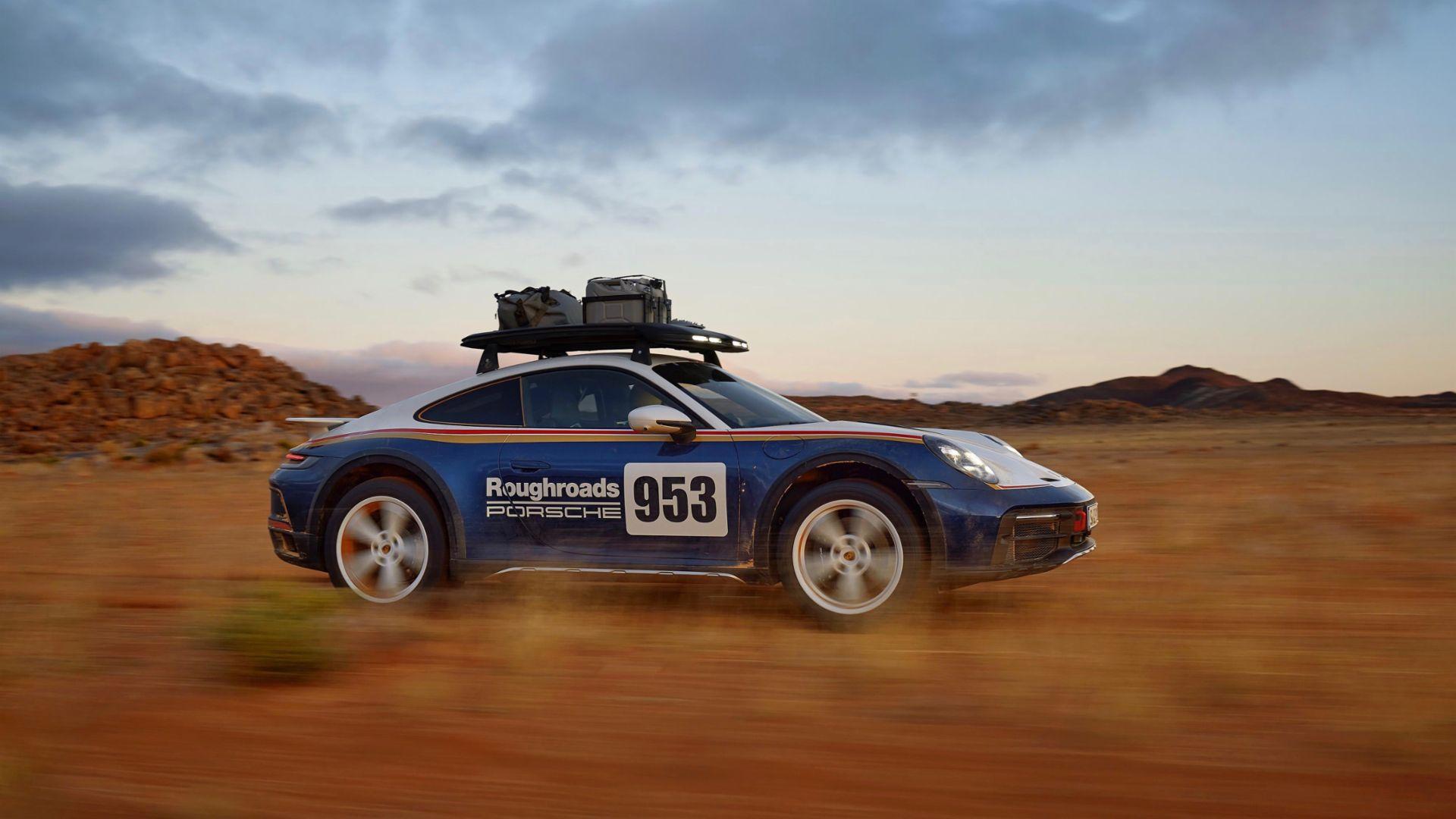
Porsche’s 911 iconic shape has always been a symbol of design evolution rather than drastic change. While it carries a legacy bound to turn heads, it’s typically subtler in its appeal compared to the striking nature of supercars. With the 911 Dakar, Porsche delicately balances this heritage with a hint of the adventurous spirit.
The Dakar differentiates itself with features like increased ride height, black bumper inserts, a sturdy fixed spoiler, and tastefully discreet arch extensions, ensuring it stands out without straying into ostentatious territory. These refinements mark Dakar as distinct from a regular 911 but avoid the pitfalls of appearing as an overdone aftermarket conversion. While the 911 Dakar retains the understated charm inherent to Porsche, its modifications signify its metamorphosis from a tracking titan to a desert dominator. Its design respects Porsche’s storied past while courageously forging ahead into new terrains.
Lamborghini Huracán Sterrato vs Porsche 911 Dakar: ENGINE AND PERFORMANCE
Quick Summary: The Lamborghini Huracán Sterrato boasts a mid-mounted 5.2-liter V-10 engine, generating 602 hp, slightly reduced from other Huracán versions to accommodate side-sealed air intakes, preventing dust entry, thus necessitating a unique roof-mounted scoop for cleaner airflow. It manages its power with a seven-speed dual-clutch automatic gearbox and an all-wheel-drive system, likely pushing speeds beyond 200 mph.
In contrast, the Porsche 911 Dakar, rooted in a rich engineering history, runs on a 3.0-liter twin-turbo flat-six engine derived from the 911 GTS, producing 473 hp. Likely coupled with a PDK dual-clutch transmission, its top speed is speculated to be in the mid-to-high 190s mph range.
Lamborghini Huracán Sterrato
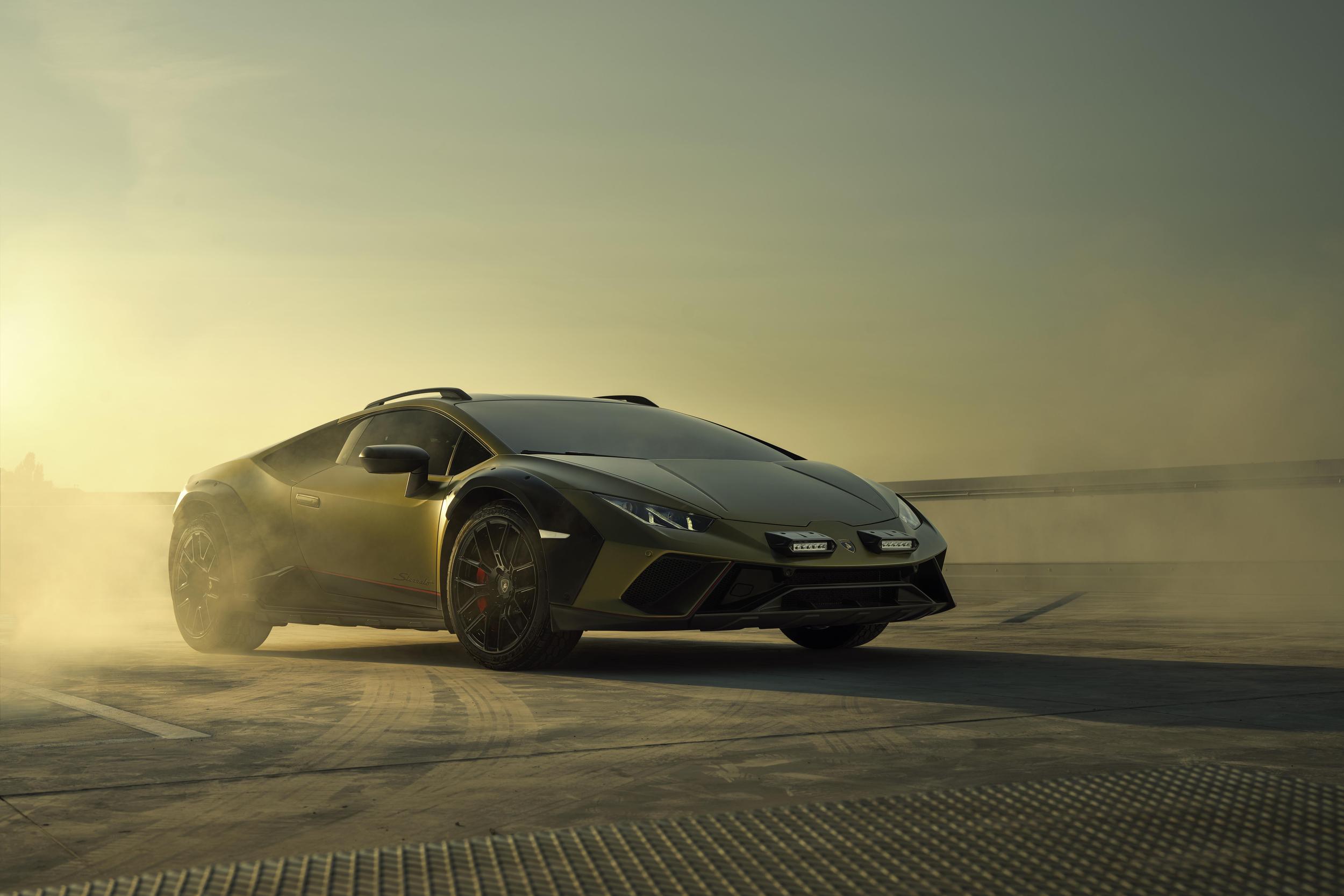
Underpinning the Huracán Sterrato’s aggressive stance is a mid-mounted 5.2-liter V-10 engine. This powerhouse produces 602 hp, slightly detuned from the 630 hp found in other Huracán variants, a choice Lamborghini made to ensure the side-mounted air intakes could be sealed off to prevent dirt and dust ingestion. This adaptation saw the introduction of a single roof-mounted scoop, ensuring clean airflow. Torque remains consistent at 413 lb-ft.
A seven-speed dual-clutch automatic gearbox channels power into an all-wheel-drive system to manage the engine’s energy. This is further enhanced by a mechanical rear limited-slip differential, crucial for maintaining traction in rugged terrains. The Huracán Sterrato’s performance is equally exhilarating, reaching 0 to 62 mph in 3.4 seconds, 0 to 124 mph in 9.8 seconds, and boasting a top speed of 161.5 mph.
Porsche 911 Dakar
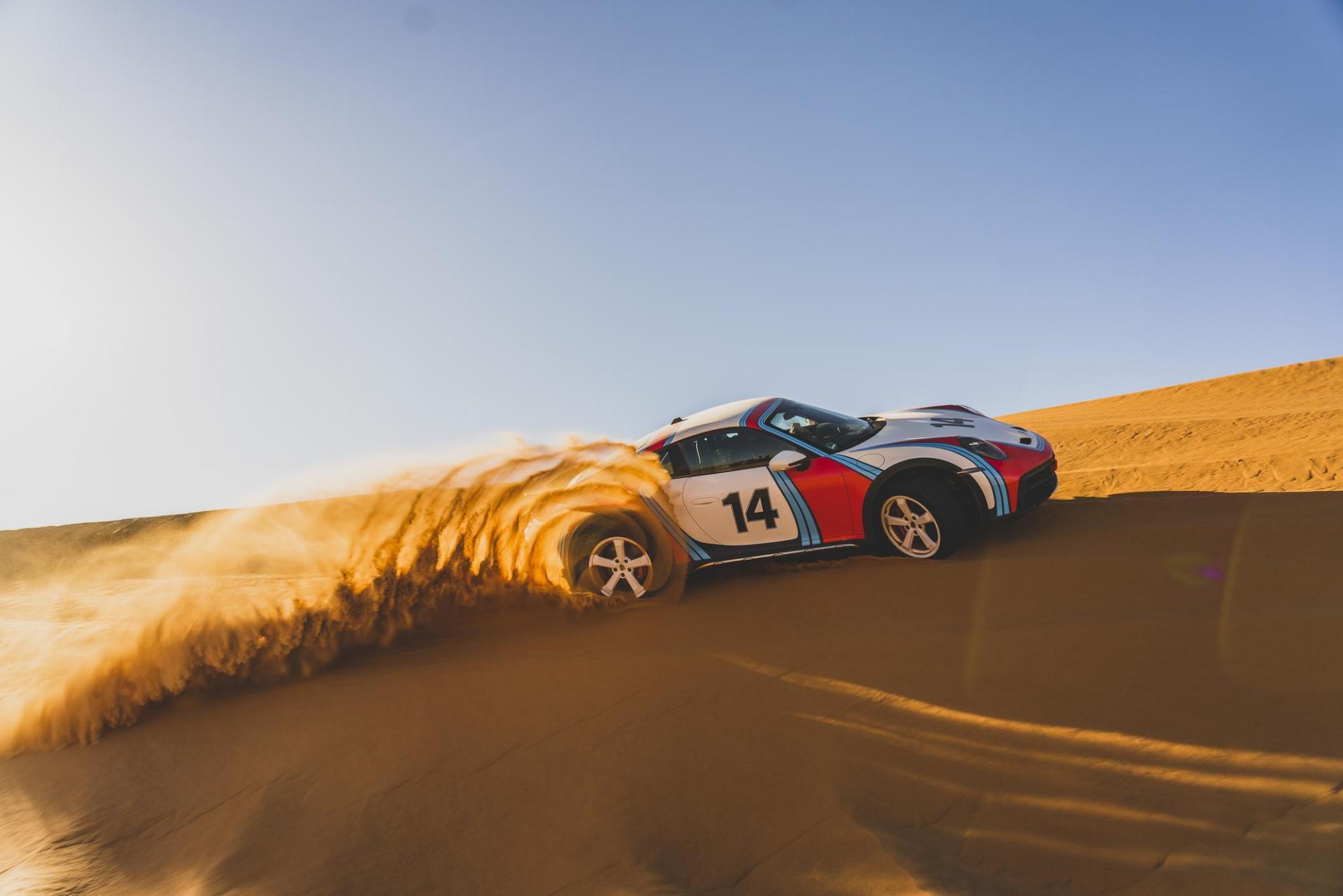
Rooted in decades of engineering excellence, the Porsche 911 Dakar showcases performance evolution while respecting its iconic lineage. Contrary to prior speculations, the 911 Dakar is powered by a 3.0-liter twin-turbo flat-six engine inherited from the 911 GTS.
This powertrain produces 473 hp, aligning it more with the higher-performance variants of the 911 family. Paired with what is likely a PDK dual-clutch transmission—synonymous with Porsche’s commitment to seamless power delivery—the Dakar stands as a symbol of the brand’s racing and performance heritage.
The Porsche 911 Dakar boasts remarkable performance, accelerating from 0 to 62 mph in a mere 3.4 seconds and achieving a top speed of 149 mph.
Lamborghini Huracán Sterrato vs Porsche 911 Dakar: Specification
| Specifications | Porsche 911 Dakar | Lamborghini Huracán Sterrato |
|---|---|---|
| Engine | 3.0-Liter twin-turbo flat-six | 5.2-Liter naturally aspirated V-10 |
| Power | 473 horsepower | 602 horsepower |
| Torque | 420 pound-feet | 413 pound-feet |
| 0-60 MPH | 3.2 seconds | 3.3 seconds |
| Top Speed | 149 MPH | 161.5 MPH |
| Transmission | 8-speed dual-clutch PDK | 7-speed dual-clutch automatic |
Lamborghini Huracán Sterrato vs Porsche 911 Dakar: Ride And Handling
Quick Summary: The Huracán Sterrato and the 911 Dakar exhibit distinct design and performance differences tailored for their off-road capabilities. The Sterrato boasts a widened track by 1.2 inches at the front and 1.3 inches at the rear, emphasizing its broader stance. This is complemented by 15-inch front brakes with six-piston calipers and bespoke Bridgestone Dueler AT002 tires on 19-inch wheels.
On the other hand, the 911 Dakar stands taller by 2.0 inches than its base variant, with an option to elevate even further by 1.2 inches, achieving a peak ride height of 7.5 inches. Unlike the Sterrato’s air suspension, the Dakar utilizes individual hydraulic lifts, and its braking components are meticulously crafted to handle off-road dust and debris.
This combination ensures that while the Sterrato brings supercar agility to off-roading, the 911 Dakar retains the quintessential Porsche driving dynamics even on rugged terrains.
Lamborghini Huracán Sterrato
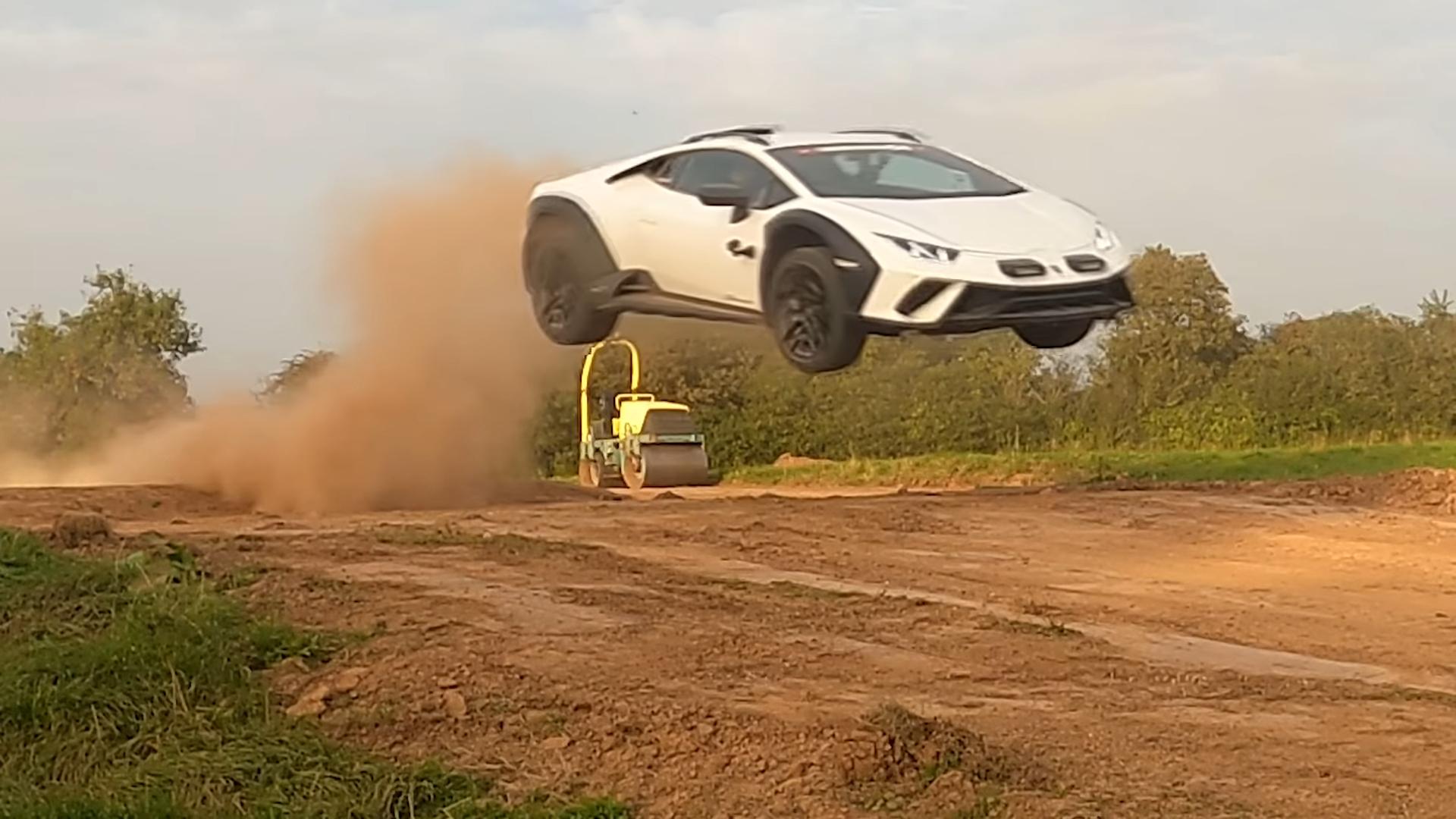
The Huracan Sterrato isn’t just taller; its stance is broader, too, extending the track by 1.2 inches up front and 1.3 inches at the rear. Naturally, it employs an all-wheel-drive system. Stopping prowess comes from robust 15-inch brakes with six-piston calipers at the front and 14-inch discs paired with four-piston calipers at the back. These are set behind 19-inch wheels, outfitted with a bespoke set of Bridgestone Dueler AT002 all-terrain run-flat tires crafted exclusively for this vehicle.
While they maintain a low-profile 40-series design, a slightly increased sidewall offers comfort and protection for off-road excursions.
With an increased ground clearance compared to its supercar siblings, the Sterrato is engineered to handle bumps, gravel, and more aggressive off-road challenges with poise. Its shock absorbers have been recalibrated and reinforced to absorb shocks while maintaining the car’s balance, ensuring that the Sterrato’s inherent supercar agility isn’t compromised.
Porsche 911 Dakar
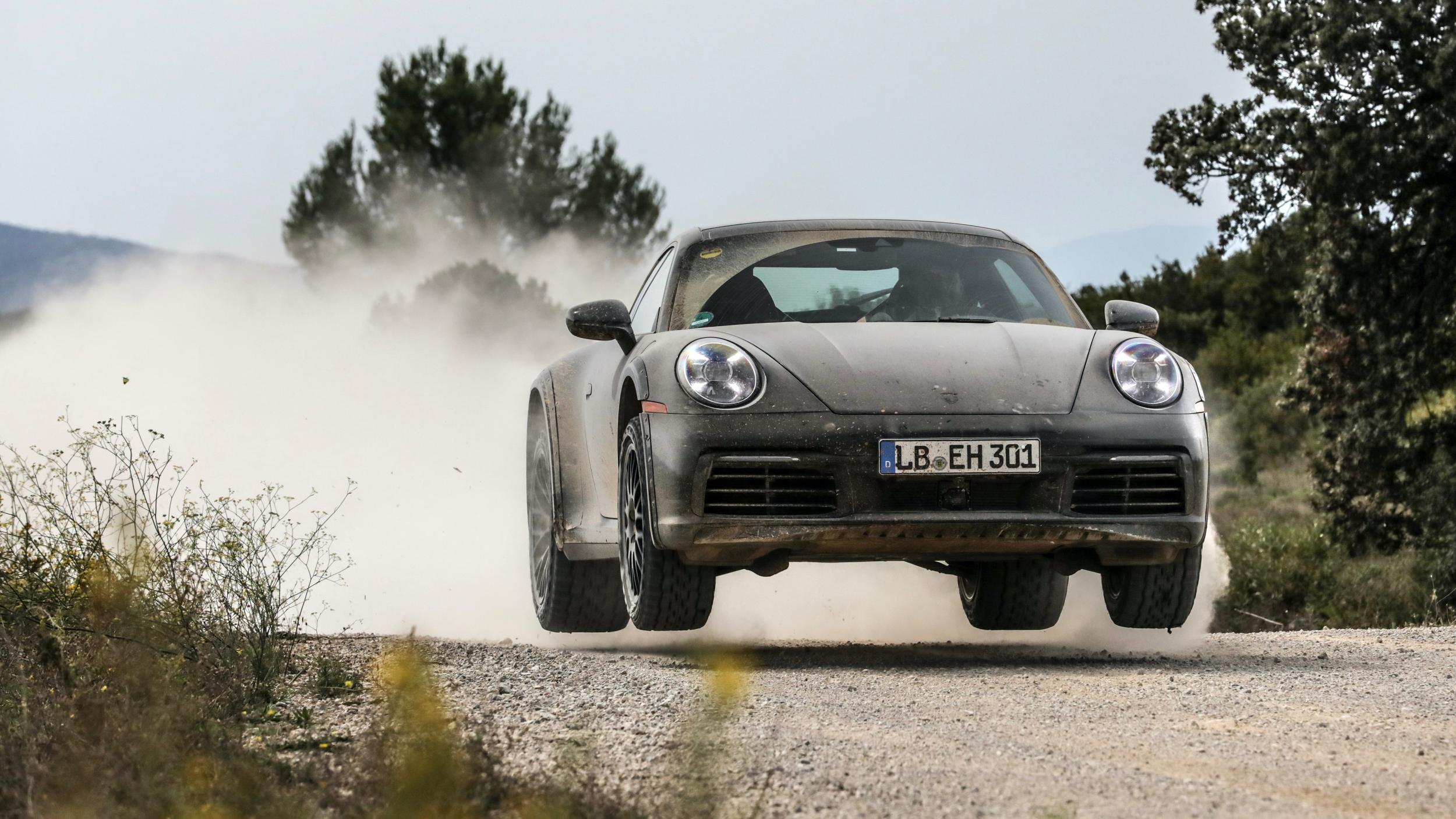
The 911 Dakar stands 2.0 inches taller than the base 911 Carrera. Additionally, it features a high-level mode that elevates the ground clearance by an extra 1.2 inches. Instead of an air suspension, the Dakar employs individual hydraulic lifts at the front and rear. This mechanism provides the 911 Dakar with a peak ride height of 7.5 inches. Notably, it possesses a commendable approach and breakover angles measuring 16.1 and 19.0 degrees, respectively. This high-level configuration isn’t exclusively for leisurely off-road adventures; the 911 Dakar can maintain this stature even at speeds reaching 105 mph. Integral to the car’s design is a rear-biased standard all-wheel-drive system and an Off-Road mode that automatically triggers the elevated ride height.
Braking is another area where the 911 Dakar excels. With race-bred brake components, the Dakar ensures rapid deceleration with pinpoint precision, whether on tarmac or gravel. The brakes are constructed to handle the dust and debris typical of off-road conditions, ensuring their performance is maintained even in the muddiest situations.
The culmination of these attributes ensures that the 911 Dakar not only conquers undulating terrains but does so while maintaining the driving dynamics Porsche fans have come to adore.
Lamborghini Huracán Sterrato vs Porsche 911 Dakar: Interior
Quick Summary: The Lamborghini Huracán Sterrato’s interior emphasizes exclusivity with its customizable Alcantara upholstery and a unique digital instrument cluster featuring pitch and roll indicators. It’s notably a two-seater, with its 8.4-inch touchscreen providing access to driving-specific features, including a digital inclinometer. However, its infotainment system falls short, offering Apple CarPlay as an option but excluding Android Auto.
In contrast, the Porsche 911 Dakar exudes a sense of familiarity, distinguished primarily by its supportive carbon-backed bucket seats and an optional roll cage instead of rear seats. A subtle build-number plaque and the availability of the Rallye Design Package with Race-Tex and leather further differentiate its interior.
The 911 Dakar’s 10.9-inch touchscreen infotainment system integrates both Apple CarPlay and Android Auto wirelessly and offers enhanced audio options, including a 12-speaker Bose and 13-speaker Burmester setup.
Lamborghini Huracan Sterrato
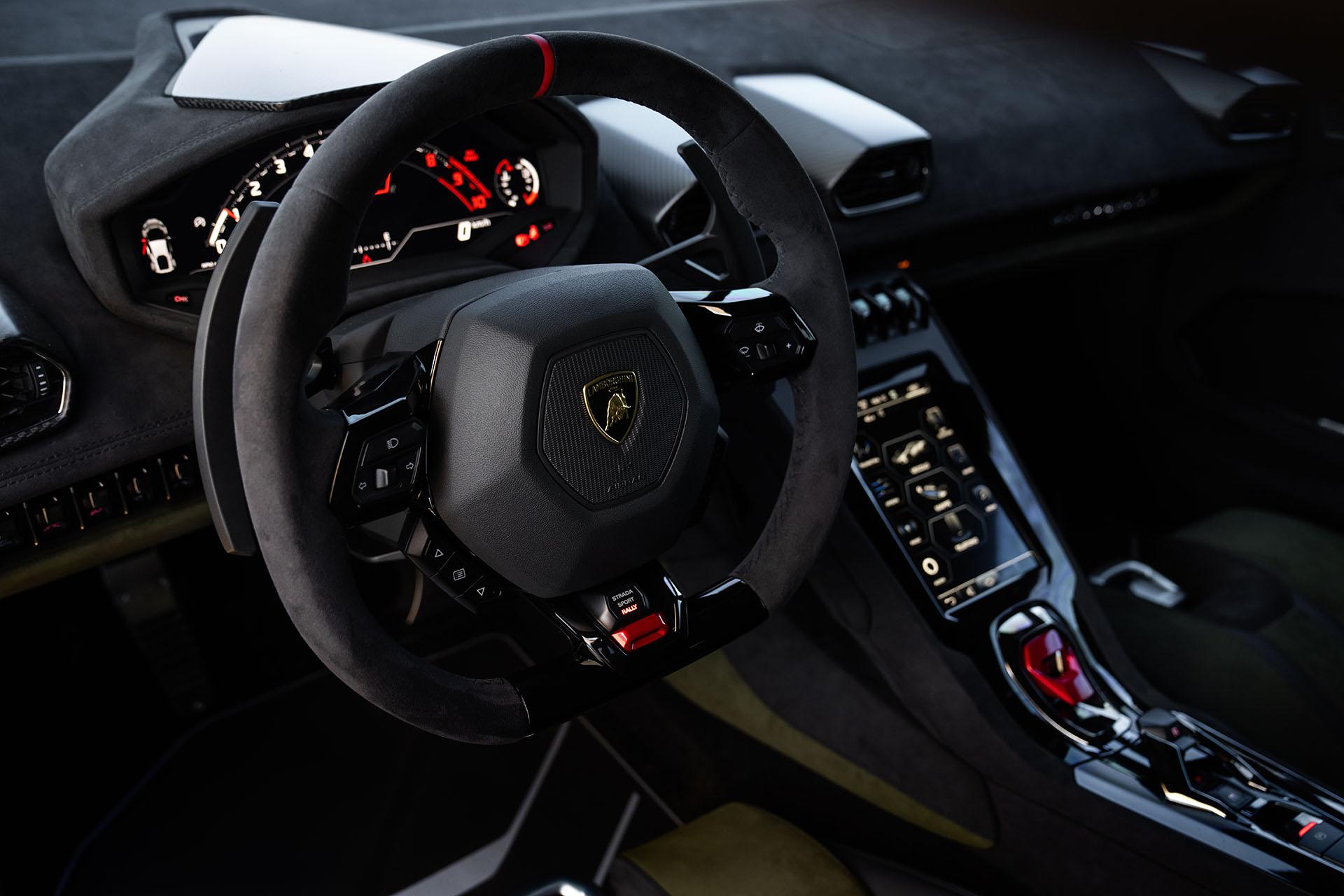
In supercars-turned-off-roaders, the interior ambiance, design ethos, and technological integration are integral in defining the driving experience. The Lamborghini Huracán Sterrato exudes an aura of exclusivity from the moment you open its door. While the changes inside are subtler than its audacious exterior, the cabin doesn’t compromise on Lamborghini’s signature sense of occasion. The exclusive Alcantara upholstery, which comfortably envelops the driver and passenger, is customizable, underscoring Lamborghini’s commitment to personalization.
This supercar’s digital realm, the Human Machine Interface (HMI), showcases revamped graphics. Notably, the instrument cluster now features a pitch and roll indicator—a nod to its off-road capabilities. Although the infotainment system may not be the cutting edge of tech modernity, using exotic materials and design cues like the steering wheel’s 12 o’clock marker firmly focuses on spirited driving. The two-seater configuration is intentional, accentuating the Sterrato’s sporty nature. Elevating the driving pleasure is an array of tech features accessible through an 8.4-inch central touchscreen.
These features, such as the digital inclinometer, steering angle indicator, and others, are tailored for driving enthusiasts. Connectivity-wise, Apple CarPlay is an option, but notably, Android Auto doesn’t make the list, though Bluetooth compatibility bridges that gap.
Porsche 911 Dakar
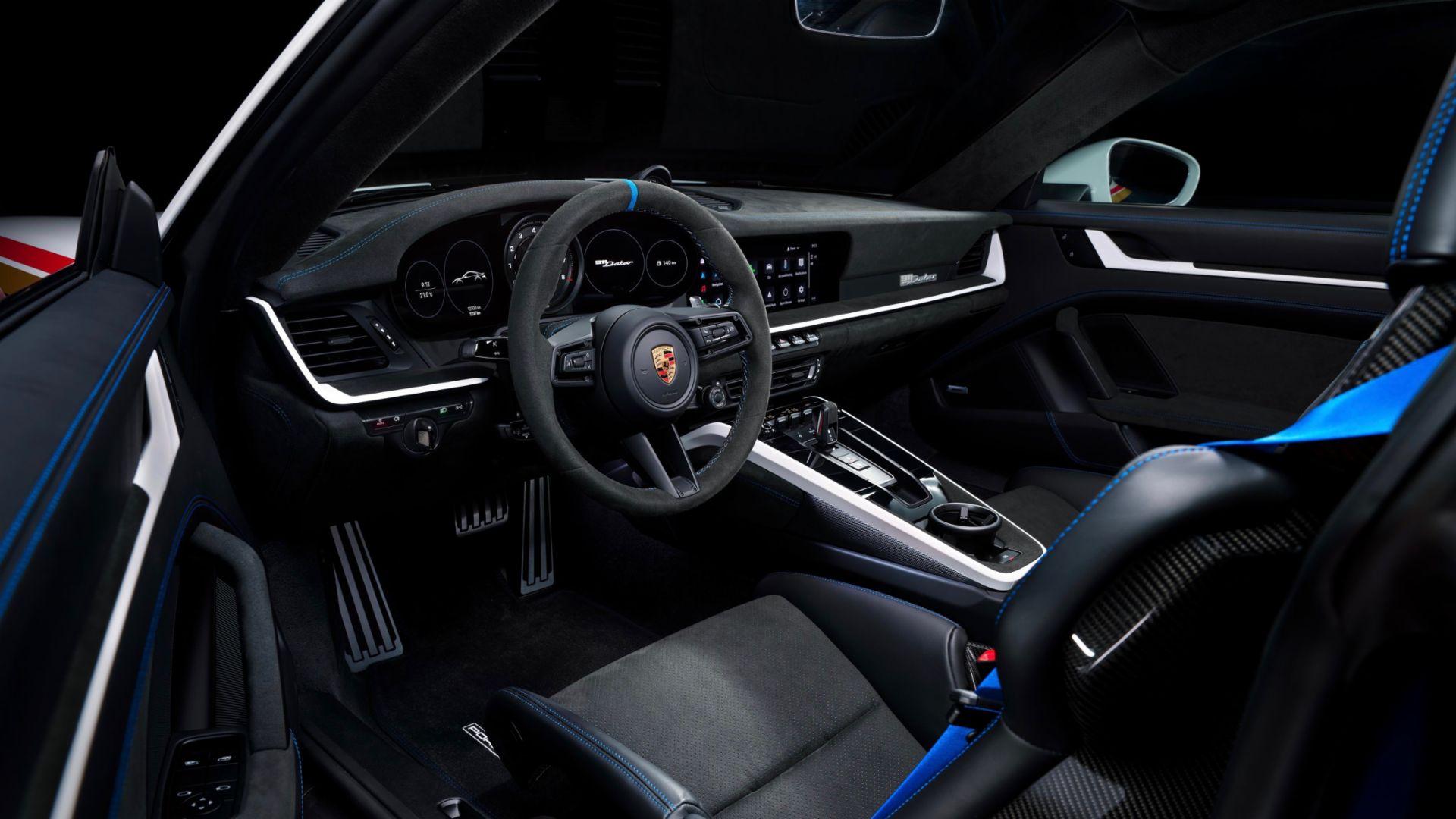
On the other hand, the Porsche 911 Dakar’s interior resonates with familiarity for those acquainted with the 911 lineup. A standout feature inside the Dakar is the carbon-backed bucket seats, which provide superior support during spirited drives. Interestingly, Porsche forgoes the rear seats, instead offering an optional roll cage—a testament to its racing genes. However, the absence of a back seat option might deter those who occasionally ferry younger passengers. Subtle exclusivities like the build-number plaque on the dashboard amplify Dakar’s uniqueness.
The Rallye Design Package introduces the cabin to Race-Tex, Porsche’s rendition of Alcantara, paired elegantly with leather. Dominating the dashboard is a 10.9-inch touchscreen, the hub of Porsche’s infotainment system. This system seamlessly integrates Apple CarPlay and Android Auto wirelessly and offers a Wi-Fi hotspot. For audiophiles, Porsche ensures an immersive auditory experience through a 12-speaker Bose system or a 13-speaker Burmester setup.
Price
The Lamborghini Huracán Sterrato, with its unmistakably aggressive and exotic design, commands a starting price of $273,177. On the other hand, the Porsche 911 Dakar, with its deep-rooted racing lineage and a nod to the legendary 911’s heritage, is priced at $222,000.
Conclusion

When luxury automakers like Lamborghini and Porsche venture into uncharted territory, it’s an exciting proposition for automobile enthusiasts. However, from a consumer’s standpoint, choosing between the Lamborghini Huracán Sterrato and the Porsche 911 Dakar is no mean feat. Both vehicles challenge the conventions of supercar design, merging racetrack prowess with off-road audacity, and therein lies their appeal.
The Huracán Sterrato, in all its glitz, epitomizes Lamborghini’s penchant for the dramatic. Its design elements, from the expansive arch flares to the audacious roof snorkel, ensure it won’t be mistaken for anything else on or off the road.
But this attention to aesthetics comes at a price—$273,177, to be exact. Furthermore, while the customizable Alcantara upholstery and a unique digital instrument cluster are undoubtedly lavish, the omission of Android Auto in its infotainment offerings is puzzling, especially for a vehicle in this price bracket. For a consumer, it’s an undeniable statement piece that requires a deeper dig into pockets and a willingness to compromise on certain contemporary conveniences.
The Porsche 911 Dakar, meanwhile, offers a nuanced take on the off-road supercar concept. It’s less extroverted than the Sterrato but maintains an unmistakable Porsche charm. Rooted in a lineage that speaks volumes about its racing pedigree, it might resonate more with purists who value the brand’s storied history. Priced at $222,000, it’s more accessible than the Sterrato. Its cabin features supportive carbon-backed bucket seats and a comprehensive infotainment system that includes Apple CarPlay and Android Auto. It showcases Porsche’s commitment to merging performance with modern-day luxuries. However, the omission of a rear seat option could be a sticking point for consumers who seek versatility.
In the final analysis, these vehicles are undoubtedly engineering marvels, presenting a thrilling blend of supercar speed and off-road resilience. But potential buyers must critically assess what they prioritize more: the audacious statement of the Sterrato or the racing lineage and nuanced luxury of the 911 Dakar.
Furthermore, they must consider the practicalities of such niche vehicles, from maintenance costs to the actual frequency of off-road use. After all, for most consumers, a vehicle isn’t just an indulgence—it’s an investment in both finance and lifestyle.


